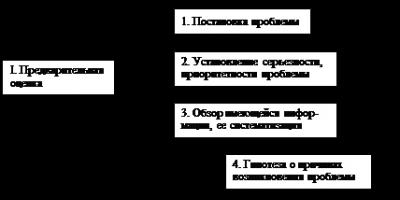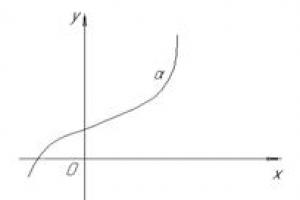Significant changes have been made to the Unified State Examination in mathematics since 2015. The exam is divided into two separate ones: a basic level and a profile level.
At the basic level, the five-point grading system is retained. To successfully pass the exam and receive a certificate, a grade of at least the usual three is required. How many tasks do you need to solve for a C in 2017? This minimum is usually set closer to the exams. And even after.) Therefore, we will focus on last year’s Unified State Examination. In 2016, a C was given for 7 to 11 correctly solved tasks. 12 - 16 tasks were rated at 4, 17 - 20, respectively, at 5.
At the profile level, the Unified State Exam grading system of previous years has been preserved. This system is quite complex. But you can roughly assess your capabilities and expected results. To assess the results of the Unified State Exam, two scales are used. Scale primary points and scale test scores . First you collect initial points, and then the converting primary scores into test scores .
Scale primary points of the Unified State Exam 2017 known from the KIM specification for conducting the Unified State Examination in mathematics (profile level). It looks like this:
Any short answer item (formerly Part B) carries one primary point. There will be 12 such tasks. Therefore, ideally, you can score twelve primary points on these tasks.
Tasks with detailed solutions 13, 14 and 15 weigh two primary points each. Tasks 16 and 17 - three points each. Tasks 18 and 19 - as many as four points each. The maximum number of initial points for completing the entire work is 32.
Please note that an assignment completed partially or with errors with a detailed solution is also graded! You can get not 4, but at least 3, 2 or 1 point. Or you may not get anything. Let me remind you that this primary points.
Converting primary scores to test scores is already underway after exam. Test scores , from 0 to 100 - these are exactly the points that go into the certificate and are taken into account by the admissions committees of various educational institutions. The methodology for converting primary scores into test scores is quite complex. The calculation takes into account the actual results of passing the Unified State Exam throughout the country. It takes 6-8 days to process the Unified State Exam results.
For these reasons, say exactly how much you will receive test scores impossible in advance. However, it is quite possible to focus on the grading scheme from previous years. Practical results converting primary scores into test scores didn't change that much.
The conversion of primary points (for completed tasks) into the usual grades and a test scale of 100 points looks like approximately So:
0 - 5 primary points – mark “2”; 0-26 test points;
6 - 12 – mark “3”; 27-50 points;
12 - 20 – mark “4”; 50-75 points;
20 - 32 – mark “5”; 75-100 points.
The minimum threshold in 2017 is 6 primary points or 27 test points.
So, the work has been submitted and you are anxiously awaiting the results. Visit websites and finally get results! If all is well, congratulations! And if not?
Is it possible to challenge the Unified State Examination score? Yes. You have two days to do this after the official announcement of the results. You need to contact your teachers, they will tell you where to find the secretary of the conflict commission. And he will tell you what and how to do. It will be appeal based on results(not to be confused with an appeal according to the procedure!).
You have the right to be present at the appeal. The conflict commission will review your work, check whether the computer correctly recognized your answers, check the progress of the decision and make a conclusion: reject the appeal, increase the number of points, reduce the number of points. Yes Yes! Maybe reduce it! It's a double-edged sword. From here:
Practical tips:
1. It makes sense to appeal the results if necessary. This is a case where the evaluation of your work does not meet expectations. Or you have nothing to lose.
For a successful appeal, it is very desirable to be confident in the correctness of the tasks completed and remember your decisions. Otherwise, even after seeing your work, you will not be able to convincingly prove that you are right. It’s not C-grade students sitting on the committee! You can practice solving examples and find out your level. Testing with instant verification. Let's learn - with interest!)
You can get acquainted with functions and derivatives.
The 2018-2019 academic year is ahead, which will be the graduation year for many Russian schoolchildren, who are already concerned about the issues of successfully passing the Unified State Exam and successfully entering a good university.
We will tell you how exam papers are checked in different subjects, how the scale for converting Unified State Exam points into grades works, and what innovations you can expect in 2019.
Principles for assessing work on the Unified State Exam 2019
Over the past few years, the Unified State Examination system in a number of subjects has undergone significant changes and has been brought to an optimal (according to the organizers) format, which makes it possible to fully assess the volume of knowledge of a graduate in a particular subject.
In 2018-2019, no fundamental changes are expected and it is safe to say that the same principles as in 2017-2018 will be applied to evaluate the work of graduates:
- automated verification of forms;
- involving experts in checking tasks with detailed answers.
How does a computer evaluate?
The first part of the examination paper involves a short answer to the questions posed, which the Unified State Examination participant must enter on a special answer form.
Important! Before starting work, be sure to read the rules for filling out the form, as incorrectly completed work will not pass the automated check.
It is quite difficult to challenge the result of a computer check. If the work was not counted due to the fault of a participant who filled out the form incorrectly, the result is considered unsatisfactory.
How do experts rate it?
In many subjects, in addition to the test part, there are tasks that require a full, detailed answer. Since it is impossible to automate the process of checking such answers, experts are involved in the verification - experienced teachers with extensive work experience.

When checking the Unified State Exam, the teacher does not know (and even with a strong desire cannot find out) whose work is in front of him and in which city (region) it was written. Testing is carried out on the basis of uniform assessment criteria developed specifically for each subject. Each work is checked by two experts. If the experts’ opinions coincide, the assessment is put on the form, but if independent appraisers disagree, then a third expert is involved in the verification, whose opinion will be decisive.
That is why it is important to write legibly and accurately so that there is no ambiguous interpretation of words and phrases.
Primary and test scores
Based on the test results, the Unified State Exam participant is awarded a certain number of primary points, which are then converted into text points (points for the entire test). Different subjects have different maximum primary points, depending on the number of tasks. But after giving the result according to the appropriate table, the Unified State Examination participant receives a final test score, which is the official result of his final tests (maximum 100 points).
So, in order to pass the exam, it is enough to achieve the established minimum threshold of the primary score:
Minimum scores |
||
primary | test |
|
Russian language | ||
Mathematics (profile) | ||
Computer science | ||
Social science | ||
Foreign languages | ||
Biology | ||
Geography | ||
Literature | ||
Based on these numbers, you can accurately understand that the exam has been passed. But what grade? The 2018 online scale will help you with this, designed specifically for converting primary Unified State Exam scores into test scores, which will also be relevant for the 2019 results. A convenient calculator can be found on the website 4ege.ru.
Announcement of official results
Graduates are always concerned with the question of how quickly they can find out what result was obtained during the test and what the scale for converting the points scored on the Unified State Exam into traditional grades will be in 2019.
Teachers often take it upon themselves to reassure students by working through the tasks of the Unified State Exam tickets immediately after the exam and assessing the quality of the students’ work and the amount of initial points scored. Official results must be waited for 8-14 days, according to the established regulations for the Unified State Exam 2019. On average, organizers approve the following inspection schedules:
- 3 days to check the work;
- 5-6 days for processing information at the federal level;
- 1 working day for approval of the results of the State Examination;
- 3 days to post results online and transfer data to educational institutions.

In the event of unforeseen situations and technical problems, these deadlines may be revised.
You can find out your owl score:
- directly at your school;
- on the portal check.ege.edu.ru;
- on the website gosuslugi.ru.
Converting points to grades
Since 2009, Unified State Examination results are not included in the graduate certificate. Therefore, today there is no official state system for converting the Unified State Examination result into a grade on a school 5-point scale. As part of the entrance campaign, the test score obtained in the exam is always summed up and taken into account. But many students are still interested in finding out how they passed the exam - 3 or 4, 4 or 5. For this, there is a special table that details the correspondence for each of the 100 points in each subject.
Estimates Using such a table is quite inconvenient. It is much easier to find out how you passed the Russian language, mathematics or history by using the online calculator 4ege.ru, which also contains a scale for converting Unified State Exam scores, which is relevant for graduates of 2019. Having received the Unified State Exam result, you should decide on a university as quickly as possible, comparing your capabilities with the real competition for the specialties you are interested in. Thus, the practice of past years shows that in some cases it is difficult to get into the most popular areas in the capital’s universities even with high scores, because not only holders of 100-point Unified State Exam results, but also winners of the largest Olympiads of the 2018-2019 academic year will compete for places.
| ||||
In the Unified State Examination in the Russian language 2017, 25 tasks are assessed, of which 24 are tests, and 25 are essays based on the text. Today, in test tasks you need to either write down words correctly (and not just find them), or find two correct answers from those proposed (task 1 and 15), or name numbers indicating the correct placement of commas. Task 7 remains difficult, where you need to correlate erroneous sentences with the rules according to which the errors were made.
|
1 point for a correct answer, 0 points for an incorrect answer |
From 0 to 2 points |
From 0 to 4 points |
From 0 to 5 points |
|
For correct completion of tasks 2–6, 8–14, 16–23 the examinee |
For completing tasks 1 and 15, you can score from 0 to 2 points. |
For completing task 24, you can score from 0 to 4 points. Faithful |
For completing task 7, you can score from 0 to 5 points. Faithful |
|
Maximum points |
|||
|
Minimum points |
|||
Essay evaluation criteria
|
Points |
||
|
Formulation of source text problems |
||
|
The examinee (in one form or another) correctly formulated one of the problems of the source text. There are no factual errors related to the understanding and formulation of the problem. |
||
|
The examinee was unable to correctly formulate any of the problems in the source text. |
||
|
Commentary on the formulated problem of the source text |
||
|
The problem formulated by the examinee is commented on. There are no factual errors related to understanding the source text in the comments. |
||
|
The problem formulated by the examinee is commented on, no more than 1 factual error was made in the comments related to understanding the source text. |
||
|
The problem formulated by the examinee was not commented on, more than 1 factual error was made in the comments related to understanding the source text, another problem not formulated by the examinee was commented on, a simple retelling of the text or its fragment is given as a commentary, A large fragment of the source text is quoted as comments. |
||
|
The examinee correctly formulated the position of the author (narrator) of the source text on the commented problem. There are no factual errors related to understanding the position of the author of the source text. |
||
|
Argumentation by the examinee of his own opinion on the problem |
||
|
The examinee expressed his opinion on the problem formulated by him, posed by the author of the text (agreeing or disagreeing with the position of the author), argued it (gave at least 2 arguments, one of which was taken from fiction, journalistic or scientific literature). |
||
|
The examinee expressed his opinion on the problem formulated by him, posed by the author of the text (agreeing or disagreeing with the position of the author), argued it (gave at least 2 arguments, based on knowledge or life experience), conducted only 1 argument from fiction, journalistic or scientific literature. |
||
|
The examinee expressed his opinion on the problem formulated by him, posed by the author of the text (agreeing or disagreeing with the position of the author), argued it (gave 1 argument), relying on knowledge, life or reading experience. |
||
|
The examinee expressed his opinion on the problem posed by the author of the text (agreeing or disagreeing with the author’s position), but did not provide arguments, the examinee’s opinion is only formally stated (for example: “I agree / disagree with the author”), not reflected in the work at all. |
||
|
SPEECH DESIGN OF AN ESSAY |
||
|
Semantic integrity, speech coherence and consistency of presentation |
||
|
The work of the examinee is characterized by semantic integrity, verbal coherence and consistency of presentation: There are no logical errors, the sequence of presentation is not broken; There are no violations of paragraph division of the text in the work. |
||
|
The work of the examinee is characterized by semantic integrity, coherence and consistency of presentation, 1 logical error was made, There is 1 violation of paragraph division of the text in the work. |
||
|
The examinee’s work reveals a communicative intent, more than 1 logical error was made, There are 2 cases of violation of paragraph division of the text. |
||
|
Accuracy and expressiveness of speech |
||
|
The work of the examinee is characterized by the accuracy of expression of thoughts and the variety of grammatical structure of speech. |
||
|
The work of the examinee is characterized by the accuracy of expression of thoughts, the monotony of the grammatical structure of speech can be traced, the work of the examinee is characterized by a variety of grammatical structure of speech, there are violations of the accuracy of expression of thoughts. |
||
|
The work of the examinee is characterized by a poor vocabulary and monotony of the grammatical structure of speech. |
||
|
LITERACY |
||
|
Compliance with spelling standards |
||
|
no spelling errors (or 1 minor error) |
||
|
1-2 mistakes were made |
||
|
more than 2-3 mistakes were made |
||
| more than 3 mistakes were made | 0 | |
|
Compliance with punctuation standards |
||
|
no punctuation errors (or 1 minor error) |
||
|
1-2 mistakes were made |
||
|
2-3 mistakes were made |
||
| more than 3 errors | 0 | |
|
Compliance with language norms |
||
|
no grammatical errors |
||
|
1-2 mistakes were made |
||
|
more than 2 mistakes were made |
||
|
Compliance with speech norms |
||
|
no more than 1 speech error was made |
||
|
2-3 mistakes were made |
||
|
more than 3 mistakes were made |
||
|
Compliance with ethical standards |
||
|
there are no ethical errors in the work |
||
|
ethical mistakes were made (1 or more) |
||
|
Maintain factual accuracy in background material |
||
|
there are no factual errors in the background material |
||
|
there were factual errors (1 or more) in the background material |
||
|
Maximum points for an essay |
When assessing literacy (K7–K10), the length of the essay should be taken into account. The assessment standards indicated in the table are developed for essays of 150–300 words. If the essay contains less than 70 words, then such work is not counted and is scored 0 points, the task is considered uncompleted.
When counting words, both independent and functional parts of speech are taken into account. Any sequence of words written without a space is counted (for example, “still” is one word, “still” is two words). Initials with a surname are considered one word (for example, “M.Yu. Lermontov” is one word). Any other symbols, in particular numbers, are not taken into account when calculating (for example, “5 years” is one word, “five years” is two words).
If the essay contains partially or completely rewritten by the examinee the text of the review of task 24 and/or information about the author of the text, then the volume of such work is determined without taking into account the text of the review and/or information about the author of the text.
When assessing an essay ranging from 70 to 150 words, the number of permissible errors of four types (K7–K10) decreases.
2 points according to these criteria are given in the following cases:
K7 – there are no spelling errors (or one minor mistake was made);
K8 – there are no punctuation errors (or one minor error was made).
1 point according to these criteria is given in the following cases:
K7 – no more than two mistakes were made;
K8 – one to three mistakes were made;
K9 – no grammatical errors;
K10 – no more than one speech error was made.
The highest score according to criteria K7–K12 is not given for work ranging from 70 to 150 words.
If the essay is a retelling or a complete rewrite of the original text without any comments, then such work in all aspects of the test (K1-K12) is scored 0 points. If the work, which is a rewritten or retold source text, contains fragments of the examinee’s text, then only the number of words that belong to the examinee is taken into account when checking. Work written without reference to the text read (not based on this text) is not graded.
In accordance with the Procedure for conducting state final certification for educational programs of secondary general education (order of the Ministry of Education and Science of Russia dated December 26, 2013 No. 1400, registered by the Ministry of Justice of Russia on February 3, 2014 No. 31205) “61. Based on the results of the first and second checks, the experts independently assign points for each answer to the tasks of the Unified State Examination paper with a detailed answer... 62. In the event of a significant discrepancy in the points given by two experts, a third check is assigned. A significant discrepancy in scores is defined in the assessment criteria for the relevant academic subject. The expert carrying out the third check is provided with information about the scores assigned by the experts who previously checked the examination work.”
A significant discrepancy is considered to be a discrepancy of 8 or more primary points between the sums of points awarded by the first and second experts for completing task 25 (for all 12 assessment positions). In this case, the third expert must give points only for those assessment positions for which the points given by the first and second experts differ.
Mathematics is one of the main subjects of the school curriculum. Graduates of the 9th and 11th grades must have basic theoretical knowledge, as well as be able to solve problems in the field of algebra and geometry. The tickets offered to schoolchildren at the final tests are designed to test these competencies.
If you are planning to enter college in 2018 or become a student at one of the country’s prestigious universities, we invite you to find out how to pass the Unified State Examination and the Unified State Examination in mathematics and evaluate exam papers.
The Main State Exam (OGE) is a form of final certification of 9th grade graduates.
Over the years, tasks for this exam have been developed by teachers themselves, taking into account the level of training of graduates and the profile of the school (gymnasium). But already in 2018, a set of tasks will be developed that will be uniform for all graduates of the 9th grade of educational institutions. Uniform assessment criteria will also be developed, which will put all ninth-graders on an equal footing.
Judging by the statements made by the head of the Ministry of Education and Science Olga Vasilyeva and her colleagues, no fundamental changes are expected in the assessment of examination papers in mathematics in 2018.
During the test, for each correct decision, the OGE participant will be awarded primary points, which will then be converted into a five-point system according to the following correspondence table:
Important! In 2018, the tickets will not include the “Real Mathematics” block, and to overcome the minimum threshold, graduates will need to score at least 4 points in the “Algebra” block and 4 points in the “Geometry” block.

Evaluation of work on the Unified State Exam 2018 in mathematics
When applying for the Unified State Exam in mathematics, 11th grade graduates can choose the level:
- basic (will be sufficient for applicants planning to enroll in philological majors or taking the Unified State Exam to obtain a document on completion of 11 grades);
- specialized (a prerequisite for entry into technical and engineering specialties).
Evaluation of Unified State Exam papers in basic level mathematics
The basic level ticket consists of one block, which includes 20 tasks from the algebra and geometry course, the answers to which must be entered in a special form.
Important! When filling out the form, you must follow the basic rules. The automatic verification system will not count the answer if it is entered incorrectly into the answer table!
The minimum passing barrier for the basic Unified State Exam in mathematics, corresponding to a grade of “3”, is 12 points, the maximum is 20 points. Thus, to receive a certificate, graduates need to solve any 12 of the proposed 20 tasks.
Evaluation of Unified State Exam papers in mathematics at the profile level
The profile level is not mandatory. This exam is chosen by graduates who want to enter a university for technical and engineering specialties. Naturally, the requirements for those taking the Unified State Exam of increased difficulty are higher.
The main differences between the profile level:
- the ticket consists of two blocks: basic and profile;
- there are profile-level tasks that require a detailed answer (recording the entire progress of the solution);
- problems with extended answers are checked by experts;
- The minimum threshold for passing is 27 points.
Solutions to profile level tasks are checked by 2 experts. The following options are possible:
- the opinions of the inspectors (scores assigned) coincide – ideal;
- the scores differ, but not significantly – the arithmetic mean between the scores from different experts is taken into account;
- The opinions of the examiners and the scores given differ significantly. In this case, a third expert is involved.
In 2018, assessment will influence the certificate and the results of the Unified State Exam in mathematics will be interpreted according to the table:

%D0%9F%D0%B5%D1%80%D0%B5%D1%81%D0%B4%D0%B0%D1%87%D0%B0%20%D0%9E%D0%93%D0%AD %20%D0%B8%20%D0%95%D0%93%D0%AD%20%D0%B2%202018%20%D0%B3%D0%BE%D0%B4%D1%83
Since assessment of knowledge in mathematics is mandatory for graduates of the 9th and 11th grades, low scores on the Unified State Exam and Unified State Exam will not allow you to receive a certificate and continue your studies at a college or university in 2018.
The reasons for a poor result can be different, from poor physical or psychological condition to a simple lack of necessary knowledge. If a student fails to achieve the required passing score on the first attempt, he will be given a second chance. Retaking the OGE and USE in mathematics will be carried out on reserve days according to the established schedule for final tests for the 2017-2018 academic year.
See also the interview in which Olga Vasilyeva told Izvestia about the 2018 Unified State Exam:
Starting in 2015, the exam has changed significantly compared to previous years. The Unified State Exam in Mathematics 2019 is divided into two separate exams: basic level and profile level. Each graduate has the right to choose the desired option. Or both at once. Just in case.)
Let's get acquainted with the innovations of the Unified State Exam?
Basic level of the Unified State Examination in mathematics 2019.
Appointment of the exam.
This is a relatively new exam. Designed for those who will not need mathematics in their further education. Either training is not offered at all, or it is offered in universities where the subject “Mathematics” is not included in the list of entrance examinations.
For any university with the subject "Mathematics" a document confirming passing the basic level of the Unified State Exam in mathematics is not suitable. Even if you passed it with an A.
Requirements for results.
The results of the basic Unified State Exam in mathematics are given in marks on a five-point scale and are not converted to a hundred-point scale. Therefore, the right to a certificate is given by the usual three.
Task 4. To complete this task, you must be able to express a variable from a formula. It's a simple matter, but not everyone succeeds.)
Task 5. This assignment may contain very basic trigonometry examples. Or, equally simple examples with logarithms.
In tasks 6, 9, 11, 12, 14 you need to be able to obtain information from tables and graphs, solve basic everyday problems to choose the best option, etc. These competency-based tasks are not simpler (but not more difficult) at the basic level than at the specialized level.
Task 7. This task tests your ability to solve simple equations from a variety of topics. The equations can be linear, they can be quadratic, they can be exponential or logarithmic, they can be all sorts of things. They are united by one remarkable property - simplicity!) The very basics, without unnecessary complications. By the way, the very basics are explained using the links provided.
Task 8, 13, 15, 16- This is elementary geometry. From very primitive to simple.)
Task 10. Probability theory problem. About the same difficulty as in the profile exam.
Task 17. This is a number axis assignment. Such tasks were not encountered at the profile level. But we met at the State Academic Inspectorate.) I must say that this task is not the simplest at the basic level.
Task 18. The ability to think and make logical conclusions is tested.
Task 19. Problem working with numbers.
Task 20. A text problem with a trick.
It should be noted that tasks 17 - 20 in the basic level more difficult short answer tasks at the profile level. Yes Yes! But the rest of the tasks will be easier.
Well, there is one more indisputable advantage of the basic Unified State Exam in mathematics 2018: there are no tasks with detailed solutions. There is no need to describe the progress of the solution and, therefore, all problems with the design disappear by themselves.)
The basics for solving tasks of the profile Unified State Examination in mathematics 2018 are posted in the relevant sections of this site. In the meantime, take note and remember these tips.
Practical tips:
1.Check your calculations carefully. Especially the short answer part. Especially if you haven’t had time to wean yourself off the calculator. The computer will not forgive the wrong answer, despite the ideal solution...
You need to check it correctly. Namely: solved the task, checked it, decide the next thing. And so a few examples. Maybe that's all. Then go back to the first one and check everything again! Checking one task several times in a row is ineffective. You will miss the mistake again and again. You need to refresh your view by checking other examples.
2. Do tasks with detailed solutions! They are so afraid that they don’t even read them. Don't be afraid! It definitely won't get any worse! These tasks can be done partially. If in tasks with a short answer points are given only for the correct answer, then in tasks with a detailed answer you can get points for an incomplete solution! You can get points even if you answer incorrectly!
3. If you are in doubt about how to formalize a decision, follow a simple rule: the course of the decision must be clear to the inspectors.
4. Follow 3 simple tips for working on the Unified State Exam. This will save you from annoying punctures.
If you like this site...
By the way, I have a couple more interesting sites for you.)
You can practice solving examples and find out your level. Testing with instant verification. Let's learn - with interest!)
You can get acquainted with functions and derivatives.









